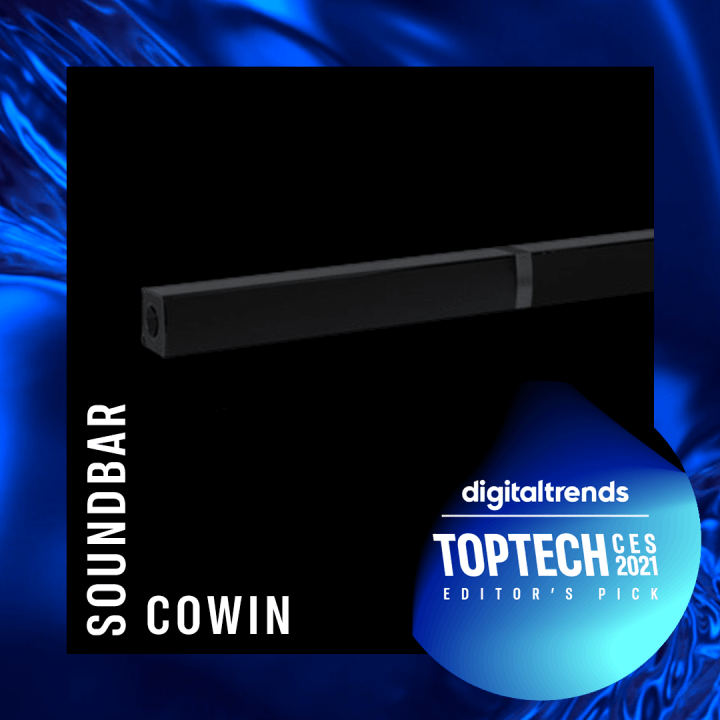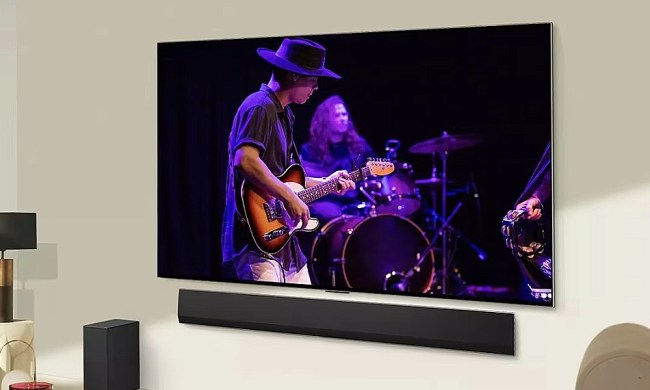Every year, CES brings a spate of new audio products, including a variety of soundbars. CES 2021 is no exception, although there are fewer soundbars on display than in years past. It goes without saying that we haven’t actually heard any of these speakers in action — CES 2021 has been an entirely virtual event. Still, several models made us pay attention, thanks to their size, features, or pricing. These are the best soundbars of CES 2021:
You can also take a look at some of the best TVs of CES 2021 as part of our larger home theater coverage.

LG QP5 Éclair
Soundbars have traditionally been seen as a simple alternative to big, complicated home theater speaker systems, so they’ve tended to be fairly big themselves. Many newer models come with almost as many speakers as the systems they’re intended to replace. Not so with LG’s tiny QP5 Éclair, a Dolby Atmos-capable soundbar that measures a mere 11.7 inches in width and 2.3 inches in height. That’s small enough to accompany even the tiniest bedroom TV.
It may be small, but it doesn’t lack power: LG claims there are 320 watts on tap. The main speaker contains five discrete drivers (including two up-firing units for height channel sound), and when paired with the wireless subwoofer, it supports 3.1.2 channel audio, Dolby Atmos, and DTS:X. Speaking of the subwoofer, it uses a bi-directional internal design to take up as little space as possible while still offering plenty of low-end oomph.
LG hasn’t confirmed pricing or availability of the QP5, but we’re hoping it comes in around the $400 mark. If it does, it will present a tantalizing alternative to the reigning small soundbars, the Sonos Beam and Bose Smart Soundbar 300, especially as neither of these speakers have subwoofers or Dolby Atmos.

JBL Bar 5.0 Multibeam Dolby Atmos soundbar
Speaking of packing Dolby Atmos into small spaces, JBL’s Bar 5.0 Multibeam Dolby Atmos soundbar is another intriguing speaker that showed up at CES 2021. Instead of relying on a wireless subwoofer, the Bar 5.0 uses four passive radiators to produce low-end bass and proprietary beamforming tech to create a virtualized Dolby Atmos experience.
At just over 27 inches in width, it’s not quite as compact as the LG QP5, but it’s only a hair wider than the Sonos Beam and the Bose Smart Soundbar 300, which means it will likely find a home in many bedrooms and small TV rooms. At $400, it’s also identically priced to these soundbars, and it packs similar features, like Apple AirPlay, and Chromecast. It works with both Google Assistant and Alexa, but it isn’t a smart speaker itself. It could be a great choice for those who want better TV sound without voice capabilities.

Cowin Soundbar
Cowin Audio isn’t exactly a household name when it comes to soundbars. But the $80 Cowin Soundbar that the company debuted at CES 2021 is proof that it’s not content with simply creating inexpensive black boxes. The Cowin Soundbar can operate as a classic soundbar, sitting under your TV or wall-mounted for a cleaner look, or you can split it into two left and right channels.
It’s not the first time we’ve seen a soundbar with detachable speakers — JBL’s ambitious Bar 9.1 is a recent example — but it is the first time we’ve seen one that actually splits into two parts. Each half is designed to stand vertically on a provided set of feet, in a more traditional, mini-floor-standing speaker arrangement.
Cowin hasn’t provided a whole lot of details on exactly what makes this soundbar tick. We don’t know how the two sides communicate when in their split vertical mode, and Cowin hasn’t indicated what kind of drivers and amps are being used to power it. For now, it has only revealed that it supports Bluetooth 4.2, AUX, optical, and has “HDMI capabilities.” Cowin expects the Cowin Soundbar to appear on Amazon and Cowin.com before the end of March 2021.

TCL Alto R1
The TCL Alto R1 may look like any other generic black-box soundbar, but it has one very exciting feature that earns it a spot on this list. You can’t see it, because it’s invisible: The Alto R1 is the first soundbar based on Roku’s Roku TV Ready wireless soundbar platform, which means you don’t need a cable to connect it to a compatible Roku TV.
The audio is delivered wirelessly over Roku’s proprietary wireless audio connection. As with all other Roku TV Ready speakers, you can configure everything using the Roku remote that came with your TV, using a simple on-screen interface.
We can’t tell you much about the Alto R1 beyond the fact that it also has Bluetooth — TCL hasn’t released pricing, availability, or any other specs. Based on our experience with TCL’s other soundbars, we expect it to be reasonably priced and it will likely sound great for the money.

Samsung HW-Q950A
Samsung’s soundbar model names don’t exactly roll off the tongue, but that’s not what matters when it comes to the company’s newest flagship. The Samsung HW-Q950A is the company’s first 11.1.4-channel soundbar and it looks like it will be a monster of immersive sound. It packs 21 custom-designed drivers, including four up-firing heigh-channel units that should give Dolby Atmos and DTS:X soundtracks a spectacular 3D treatment.
If you’re fortunate enough to pair the HW-Q950A with one of Samsung’s 2020 or 2021 QLED TVs, you’ll be able to push that level of immersion even further thanks to Q-Symphony, a feature that synchronizes the TV’s built-in speakers with those of the soundbar.
As massively room-filling as we expect the HW-Q950A to sound, it’s the built-in tech that really helps this soundbar stand out from the Dolby Atmos crowd. Using a new feature called Space Fit, an AI-powered auto-calibration system, the soundbar takes advantage of the microphones built into the main enclosure and one built into the wireless subwoofer to detect and adapt to your room’s shape and acoustic properties. Best of all, you don’t need to do a thing to benefit from it.
Add on cool extras like 1-click bass boost, a game mode, and Tap Sound (which automatically pairs your phone to the soundbar over Bluetooth) and it’s clear that the Samsung HW-Q950A is the most powerful soundbar at CES 2021.



